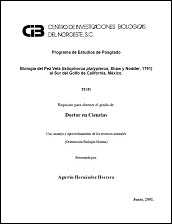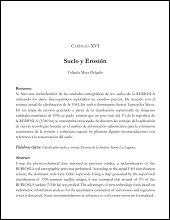Firma del ENSO en el Golfo de California: Temperatura superficial del mar y biomasa fitoplanctónica
Resumen
En este estudio se analiza la variabilidad interanual de la Temperatura Superficial del Mar (TSM) y la concentración de clorofila (Chl-a) en el Golfo de California durante los períodos 1984-2004 y 1997-2006 en base a datos generados por sensores remotos, asimismo se analiza su relación con el El Niño-Oscilación del Sur (ENSO; por sus siglas en ingles). Los patrones principales de variabilidad interanual fueron obtenidos en base al análisis de Funciones Empíricas Ortogonales (FEOs) y se compararon con el índice de Oscilación del Sur (SOI), el índice Multivariado de El Niño (MEI) y el índice de oscilación Decadal (PDO).,. La variabilidad interanual de la TSM representada por la FEO1 contabilizó el 80% de la varianza y su serie de amplitudes temporales fue significativamente correlacionada con el SOI (R = –0.58, P < 0.01). Se observó que la relación estadística mejora durante el invierno, lo que sugiere que la variabilidad interanual de la TSM puede deberse al forzamiento de los eventos de El Niño vía teleconexión atmosférica, interrumpiendo las surgencias de invierno a lo largo de la costa este del golfo. Se observo que eventos tipo-El Niño 1997-1998 se propagan a lo largo de las costas de Norteamérica sufriendo un ligero decaimiento cuando se propaga al interior del golfo para después continuar su propagación hacia el polo. La variabilidad de la amplitud del ciclo anual de la TSM analizada a lo largo de un transecto central del golfo, mostró gran afinidad con los eventos fríos del ENSO (La Niña) con amplitudes anuales del orden de ~4°C desde la boca del golfo a la región de las grandes islas, en esta última, la amplitud se comporta de manera diferente al resto del golfo, mientras que en la zona norte la variabilidad se atenúa considerablemente. La FEO1 (74 % de la varianza) presenta un patrón homogéneo a lo largo del golfo asociado con la irradiancia solar utilizada para el cálculo de las anomalías mientras que la FEO2 presenta un patrón en fase pero correlacionado negativamente entre la zona sur y la zona norte. Sus series de amplitudes anuales fueron correlacionadas significativamente con el MEI (r = –0.72, P < 0.01) y pobremente por el PDO (r = –0.35, P < 0.01). La variabilidad interanual de la Chl-a se analizó en base a un análisis de FEOs y de regresiones lineales generadas con el ENSO (índice MEI). Los resultados indican un fuerte impacto de los eventos ENSO sobre la concentración de pigmentos en el golfo pero no igual en todas las regiones [...] In this study it analyzed the interannual variability of the sea surface temperatura (sst) and the chloropyll a concentration (Chl-a) in the Gulf of California using remote sensing data and theirs relationship with the El Niño-South Oscillation (ENSO). The interannual variability patterns. We used empirical orthogonal function analysis to extract the principal mode of the non-seasonal sst and Chl-a variability and compared it to the spatial signature of the Southern Oscillation Index (SOI), Multivariated El Niño Index (MEI) and the Pacific Decadal Oscillation (PDO). The interannual variability patterns of the sst represented by the first mode, accounted for 80% of non-seasonal variability and its amplitude time series was significantly correlated to the Southern Oscillation Index (r = –0.58, P < 0.01). The amplitude of this mode and its statistical relation to the El Niño is stronger during winter, which suggests that forcing of sea surface temperature variability occurs through the disruption of the wind-driven upwelling corridor along the eastern coast due to El Niño-related atmospheric teleconnections. It was observed that the signal of the strong 1997-1998 El Niño event poleward propagation reach the mouth of the gulf and continue its poleward propagation to the interior of the gulf and along the west coast of the peninsula slightly delayed. The sst annual cycle amplitude was analysed along the gulf, showed a high relationship with cold ENSO events (La Niña) with annual amplitudes about ~4°C since the mouth to the big island region, in this area, the variability was showed different respect to the rest to the gulf. The variability was low in the northern area. The EOF1 accounted for 74% of non-seasonal variability and showed an homogeneos pattern along the gulf related to the solar irradiance used to obtain the interannual anomaly pattern. The EOF2 showed a pattern in phase but as a negative correlation between the south-north zone. Its amplitude time series was significantly correlated to the MEI (R = –0.75, P < 0.01) and little with the PDO (R = -0.31). ENSO impacts on the Gulf of California ecology remains a matter of controversy, because of contrasting field observations [...]
Colecciones
Ítems relacionados
Mostrando ítems relacionados por Título, autor o materia.
-
PROMOCIÓN DEL PERIFITON PARA EL CULTIVO DE CAMARÓN BLANCO: HACIA UNA ACUICULTURA ECOLÓGICA
DOMENICO VOLTOLINA LOBINA; JUAN MANUEL AUDELO NARANJO; MARIA DEL ROSARIO PACHECO MARGES -
Suelo y Erosión
YOLANDA LOURDES MAYA DELGADO


